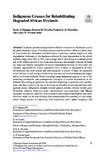| dc.contributor.author | Mganga, K. Z. | |
| dc.contributor.author | Nyariki, Dickson M. | |
| dc.contributor.author | Musimba, N. K. R. | |
| dc.contributor.author | Mwang’ombe, A. W. | |
| dc.date.accessioned | 2019-07-24T06:11:41Z | |
| dc.date.available | 2019-07-24T06:11:41Z | |
| dc.date.issued | 2019 | |
| dc.identifier.citation | Agriculture and Ecosystem Resilience in Sub Saharan Africa pp 53-68 | en_US |
| dc.identifier.uri | https://link.springer.com/chapter/10.1007/978-3-030-12974-3_3 | |
| dc.identifier.uri | https://www.researchgate.net/publication/333317394_Indigenous_Grasses_for_Rehabilitating_Degraded_African_Drylands | |
| dc.identifier.uri | http://hdl.handle.net/123456789/4217 | |
| dc.identifier.uri | http://repository.seku.ac.ke/handle/123456789/4455 | |
| dc.identifier.uri | https://researchportal.helsinki.fi/en/publications/indigenous-grasses-for-rehabilitating-degraded-african-drylands | |
| dc.description.abstract | Drylands provide an important livelihood stream to its inhabitants across the globe through a range of products and ecosystem services. However, these fragile ecosystems are threatened and believed to experience various degrees of land degradation. Estimates of the landmass affected by land degradation in the global drylands range from 10% to 20%, a percentage that is increasing at an annual global rate of 12 million ha of soil lost from desertification and drought. African drylands are especially highly susceptible to severe degradation because of their poor soil structure aggravated by scarce vegetation cover. Causes of degradation in these environments are both natural and anthropogenic in nature. Change in vegetation cover, decline in soil fertility, biodiversity loss and soil erosion demonstrate degradation in African drylands. Grass reseeding using indigenous species is one of the promising sustainable land management strategies to combat degradation in the drylands. Reseeding programmes are aimed at improving vegetation cover and biomass, and they conserve the soil to an extent not possible by grazing and land management alone. Indigenous drought-tolerant grasses notably African foxtail grass (Cenchrus ciliaris), bush rye grass (Enteropogon macrostachyus) and Maasai lovegrass (Eragrostis superba) have produced promising rehabilitation outcomes. Previous studies in African drylands have demonstrated the potential of such indigenous forage grasses in improving both vegetation cover (plant frequency and densities, basal cover) and soil hydrological properties (increased infiltration capacity, reduced runoff and sediment production) as indicators of rehabilitation success. Despite their comparative and widespread success, natural and anthropogenic challenges persist. This makes reseeding programmes a risky and often expensive venture, especially for the resource-poor pastoral communities in African drylands. Despite the risks, grass reseeding using indigenous pastures remains a viable sustainable land management option to combat degradation in African drylands. However, to ensure its continued success in the long term, multifaceted approaches and strategies that will integrate land and water management and seed systems suitable for African drylands need to be developed, strengthened and promoted. | en_US |
| dc.language.iso | en | en_US |
| dc.subject | Degradation | en_US |
| dc.subject | Reseeding | en_US |
| dc.subject | Desertification | en_US |
| dc.subject | Vegetation cover | en_US |
| dc.subject | Infiltration capacity | en_US |
| dc.subject | Runoff | en_US |
| dc.title | Indigenous Grasses for Rehabilitating Degraded African Drylands | en_US |
| dc.type | Book chapter | en_US |

